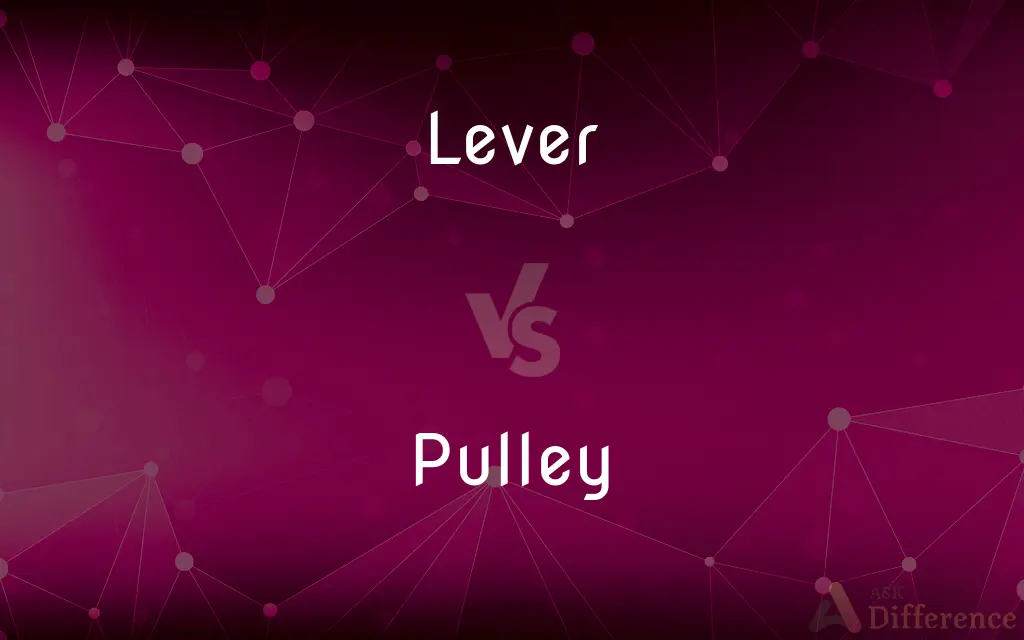Lever vs. Pulley — What's the Difference?
By Tayyaba Rehman — Updated on October 9, 2023
A Lever is a rigid bar pivoting on a fixed point amplifying force, while a Pulley uses ropes and wheels to change the direction and magnify force.

Difference Between Lever and Pulley
Table of Contents
ADVERTISEMENT
Key Differences
Both Lever and Pulley are simple machines that help amplify force, but they operate using different principles. A Lever is essentially a rigid bar that pivots or rotates about a fixed point known as the fulcrum. By applying force at one end of this bar, we can move or lift objects at the other end. On the other hand, a Pulley consists of a wheel with a grooved rim where a rope or belt can run, making it easier to lift or move loads.
Lever can be found in various forms like crowbars, bottle openers, or seesaws, each allowing for mechanical advantage based on the position of the fulcrum. A Pulley, by contrast, can be utilized in systems like elevators, cranes, or blinds, changing the direction of force and often reducing the amount of effort needed.
The versatility of a Lever lies in its three classes, determined by the relative positions of the fulcrum, effort, and load. Whether it's prying open a can of paint or using scissors, the Lever offers varied applications. The Pulley's utility is showcased in its single or multiple wheel configurations. A single Pulley primarily changes the direction of force, while a system of Pulleys, known as block and tackle, offers a mechanical advantage, lessening effort.
Lever and Pulley are foundational in understanding mechanics. While the Lever involves using a rigid structure and a fulcrum to achieve force magnification, the Pulley employs wheels and ropes, providing both change in force direction and amplification. Their distinct designs and operations have made them indispensable tools throughout history.
Comparison Chart
Basic Definition
Rigid bar pivoting about a fixed point.
Wheel with a grooved rim, utilizing ropes to move loads.
ADVERTISEMENT
Principle
Amplifies force using fulcrum and rigid bar.
Changes force direction and can amplify force with ropes & wheels.
Common Uses
Crowbars, seesaws, bottle openers.
Elevators, cranes, blinds.
Mechanical Advantage
Determined by the relative positions of fulcrum, effort, and load.
Gained by using multiple wheels in tandem.
Components
Rigid bar, fulcrum.
Rope, wheel with a grooved rim.
Compare with Definitions
Lever
A rigid bar pivoting about a fixed point to amplify force.
The seesaw at the playground is a type of Lever.
Pulley
A tool that can provide mechanical advantage with multiple wheels.
The crane uses a Pulley system to lift heavy cargo.
Lever
Simple machine that offers mechanical advantage.
Using a crowbar, the Lever action helps lift heavy objects.
Pulley
Simple machine altering force direction and magnitude using ropes.
Gym equipment often employs Pulley mechanisms for resistance adjustments.
Lever
Mechanical principle present in various everyday tools.
The nail clipper uses Lever action to clip nails.
Pulley
A wheel with a grooved rim where a rope runs to change force direction.
The flagpole has a Pulley system for raising and lowering the flag.
Lever
A lever ( or US: ) is a simple machine consisting of a beam or rigid rod pivoted at a fixed hinge, or fulcrum. A lever is a rigid body capable of rotating on a point on itself.
Pulley
Mechanical device used for lifting or moving loads.
Elevators use Pulley systems to move between floors.
Lever
A rigid bar resting on a pivot, used to move a heavy or firmly fixed load with one end when pressure is applied to the other
A tyre lever
Pulley
Device pivotal in various industries for load handling.
Conveyor belts utilize Pulley systems for operation.
Lever
Lift or move with a lever
She levered the lid off the pot with a screwdriver
Pulley
A pulley is a wheel on an axle or shaft that is designed to support movement and change of direction of a taut cable or belt, or transfer of power between the shaft and cable or belt. In the case of a pulley supported by a frame or shell that does not transfer power to a shaft, but is used to guide the cable or exert a force, the supporting shell is called a block, and the pulley may be called a sheave.
Lever
A simple machine consisting of a rigid bar pivoted on a fixed point and used to transmit force, as in raising or moving a weight at one end by pushing down on the other.
Pulley
A wheel with a grooved rim around which a cord passes, which acts to change the direction of a force applied to the cord and is used to raise heavy weights.
Lever
A projecting handle used to adjust or operate a mechanism.
Pulley
Hoist with a pulley
The tree house was built on the ground and pulleyed into the branches
Lever
A means of accomplishing; a tool
Used friendship as a lever to obtain advancement.
Pulley
A simple machine consisting essentially of a wheel with a grooved rim in which a pulled rope or chain can run to change the direction of the pull, for example to lift a load.
Lever
To move or lift with a lever
Levered up the manhole cover.
Pulley
A wheel turned by or driving a belt.
Lever
To move (oneself, for example) in a manner resembling the use of a lever
"[He] levered himself out the window all the way to his waist" (Stephen King).
Pulley
One of the simple machines; a sheave, a wheel with a grooved rim, in which a pulled rope or chain lifts an object (more useful when two or more pulleys are used together, as in a block and tackle arrangement, such that a small force moving through a greater distance can exert a larger force through a smaller distance).
Lever
To fund at least in part with borrowed money; leverage.
Pulley
(transitive) To raise or lift by means of a pulley.
Lever
(mechanics) A rigid piece which is capable of turning about one point, or axis (the fulcrum), and in which are two or more other points where forces are applied; — used for transmitting and modifying force and motion.
Pulley
A wheel with a broad rim, or grooved rim, for transmitting power from, or imparting power to, the different parts of machinery, or for changing the direction of motion, by means of a belt, cord, rope, or chain.
Lever
Specifically, a bar of metal, wood or other rigid substance, used to exert a pressure, or sustain a weight, at one point of its length, by receiving a force or power at a second, and turning at a third on a fixed point called a fulcrum. It is usually named as the first of the six mechanical powers, and is of three kinds, according as either the fulcrum F, the weight W, or the power P, respectively, is situated between the other two, as in the figures.
Pulley
To raise or lift by means of a pulley.
Lever
A small such piece to trigger or control a mechanical device (like a button).
Pulley
A simple machine consisting of a wheel with a groove in which a rope can run to change the direction or point of application of a force applied to the rope
Lever
(mechanics) A bar, as a capstan bar, applied to a rotatory piece to turn it.
Lever
(mechanics) An arm on a rock shaft, to give motion to the shaft or to obtain motion from it.
Lever
A crowbar.
Lever
(rare) A levee.
Lever
(transitive) To move with a lever.
With great effort and a big crowbar I managed to lever the beam off the floor.
Lever
To use, operate or move (something) like a lever (physically).
Lever
To use (something) like a lever (in an abstract sense).
Lever
To increase the share of debt in the capitalization of a business.
Lever
(obsolete) Rather.
Lever
More agreeable; more pleasing.
Lever
Rather.
For lever had I die than see his deadly face.
Lever
A rigid piece which is capable of turning about one point, or axis (the fulcrum), and in which are two or more other points where forces are applied; - used for transmitting and modifying force and motion. Specif., a bar of metal, wood, or other rigid substance, used to exert a pressure, or sustain a weight, at one point of its length, by receiving a force or power at a second, and turning at a third on a fixed point called a fulcrum. It is usually named as the first of the six mechanical powers, and is of three kinds, according as either the fulcrum F, the weight W, or the power P, respectively, is situated between the other two, as in the figures.
Lever
A bar, as a capstan bar, applied to a rotatory piece to turn it.
Lever
A rigid bar pivoted about a fulcrum
Lever
A simple machine that gives a mechanical advantage when given a fulcrum
Lever
A flat metal tumbler in a lever lock
Lever
To move or force, especially in an effort to get something open;
The burglar jimmied the lock
Raccoons managed to pry the lid off the garbage pail
Lever
Tool using a fulcrum to change force direction and magnitude.
Bottle openers employ Lever mechanics to remove caps.
Lever
Device with three classes based on load, effort, and fulcrum positions.
Scissors function as a Lever, with the pivot acting as the fulcrum.
Common Curiosities
Why might one choose a Pulley system over a Lever for lifting?
Pulley systems can provide a change in force direction and can be easily scaled with multiple wheels for greater mechanical advantage.
What determines the mechanical advantage of a Lever?
It's determined by the relative positions of the fulcrum, effort, and load.
What is a Lever's primary function?
A Lever amplifies force using a rigid bar pivoting about a fixed point called a fulcrum.
Are there different types of Pulley systems?
Yes, there are single Pulleys and systems with multiple Pulleys, like the block and tackle, each offering different advantages.
Can a Lever and Pulley be used together?
Yes, Lever and Pulley systems can be combined in machines for various mechanical advantages.
How does the position of the fulcrum affect a Lever's operation?
The fulcrum's position determines the Lever's class and its mechanical advantage.
How does a Pulley change the direction of force?
A Pulley uses a wheel and rope, allowing the force to be applied in a direction different from the load's movement.
Where might you commonly find a Lever in daily life?
Common examples include seesaws, scissors, and bottle openers.
How do multiple Pulleys enhance the mechanical advantage?
Multiple Pulleys, when used in tandem, reduce the effort required to lift or move a load.
Which simple machine is more versatile, Lever or Pulley?
Both Lever and Pulley are versatile in their own right, with varied applications based on specific requirements.
Share Your Discovery

Previous Comparison
Interlock vs. Overlock
Next Comparison
Accident vs. InjuryAuthor Spotlight
Written by
Tayyaba RehmanTayyaba Rehman is a distinguished writer, currently serving as a primary contributor to askdifference.com. As a researcher in semantics and etymology, Tayyaba's passion for the complexity of languages and their distinctions has found a perfect home on the platform. Tayyaba delves into the intricacies of language, distinguishing between commonly confused words and phrases, thereby providing clarity for readers worldwide.















































